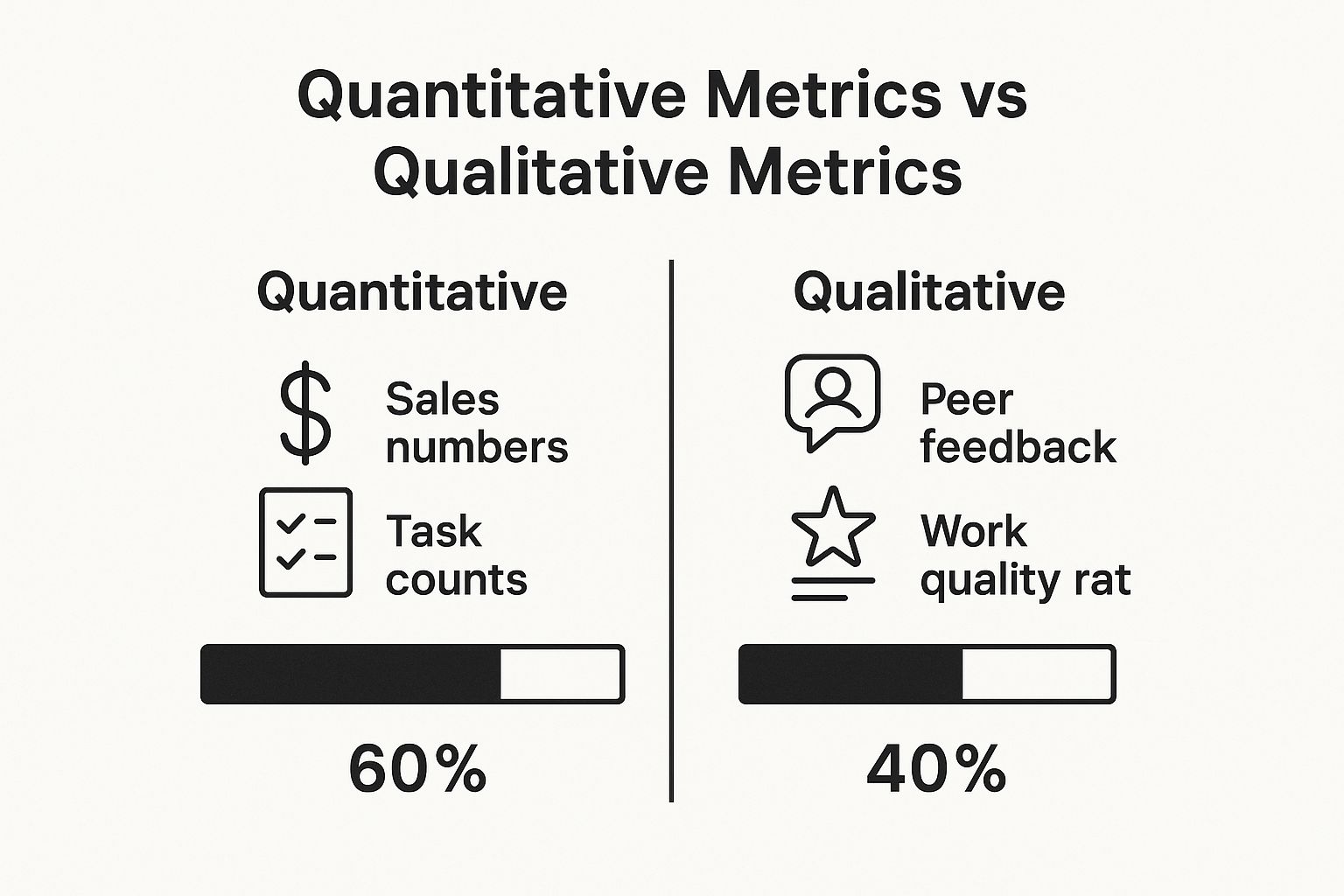
 18 minutes read
18 minutes read
Let's be real. The way most firms evaluate employee performance is a soul-crushing, time-sucking disaster. It’s a once-a-year ritual of awkward conversations, forced rankings, and goals so old they’ve started collecting dust. I’ve lived through enough of them to know they’re broken.
The secret to doing it right? You have to kill the annual review. Instead, build a simple system of continuous, honest feedback. It’s about combining hard data with human insight and making these conversations a normal part of your week, not some dreaded, high-stakes theatrical performance.
The classic annual review is a dinosaur. I've been on both sides of that mahogany table, and it’s a masterclass in inefficiency. It rarely captures what an employee actually contributes, and it’s designed to judge the past instead of building the future.
Hope you enjoy spending your afternoons fact-checking goals from last January—because that’s now your full-time job.
The good news? The game has changed. We're moving from that yearly scramble to a system that values progress over perfection and conversation over confrontation. It's time to catch up.
This isn't just my opinion; it's a massive industry shift. Back in 2016, a whopping 82% of companies were still clinging to traditional annual reviews. By 2019, that number had plummeted to just 54%.
Why the sudden change of heart? Because leaders finally realized that waiting 12 months to fix a problem is like waiting for your office to burn down before calling the fire department. It’s just bad business. You can discover more about this trend in performance management statistics and see why the old model is on life support.
So, how do you build a system that actually works? It starts with a balanced scorecard. You can’t just measure billable hours and call it a day, and you can’t rely solely on a manager's gut feeling. You need both.
This infographic breaks down the balance between quantitative (the "what") and qualitative (the "how") metrics.

The key insight here? While numbers tell part of the story, they don't capture critical behaviors like collaboration or initiative. A balanced approach stops you from rewarding a high-billing jerk or overlooking a quiet but indispensable team player.
To show you just how different this is, let’s put the old way and the smart way head-to-head.
| Characteristic | The Old Way (Annual Review) | The Smart Way (Continuous Feedback) |
|---|---|---|
| Frequency | Once a year (if you're lucky) | Weekly or bi-weekly check-ins; quarterly reviews |
| Focus | Backward-looking; rating past performance | Forward-looking; coaching for future growth |
| Tone | Formal, judgmental, and often confrontational | Collaborative, supportive, and conversational |
| Source of Feedback | Top-down (manager to employee only) | 360-degree (peers, managers, self-reflection) |
| Goal Setting | Annual, rigid, and usually irrelevant by March | Quarterly, flexible, and tied to firm priorities |
| Outcome | Stress, disengagement, and a focus on ratings | Growth, alignment, and real-time problem-solving |
The goal is no longer to judge people—it's to develop them. And this isn't about jamming more meetings onto your calendar. It's about a simple, repeatable rhythm.
Here’s the foundation:

This approach transforms performance evaluation from a yearly judgment into an ongoing partnership. It gives you real-time data, so you can course-correct instantly instead of letting small issues fester into career-limiting problems.
This is non-negotiable when managing remote talent. For instance, with virtual legal assistant services, clear goals and constant feedback are the only things preventing your remote team from becoming a disconnected island.
Now, let’s dismantle the old model piece by piece and give you a practical playbook.
If your firm’s goals sound like they were pulled from a corporate buzzword generator—"synergize core competencies to leverage market disruption"—you've already lost. Your team can't hit a target they can't see, and honestly, they won't even try. A great performance evaluation doesn't start in the review meeting; it starts months earlier with goals that are crystal-clear.

And I'm not just talking about the tired old SMART acronym we've all been beaten over the head with. I’m talking about drawing a direct line from a paralegal’s daily grind to the firm's bottom line. When someone understands how their work helps win cases, they find a whole new gear.
The real magic happens when you stop dictating goals and start co-creating them. An employee who helps set their own objectives feels ownership, not obligation. It’s the difference between telling someone to "improve client communication" and collaborating on a goal like, "reduce average client response time by 25% this quarter." One is a wish; the other is a target.
Here’s a simple way to get there:
Just like that, a fuzzy corporate mission becomes a personal, measurable objective.
But let's be real—not everything that matters can be measured in billable hours. What about the senior paralegal who mentors junior staff? Or the legal assistant who spots a flaw in your filing process? Those contributions are pure gold, but they don't fit neatly on a spreadsheet.

I’ve learned the hard way that ignoring soft skills is a recipe for a toxic culture. You end up rewarding the "brilliant jerks" who hit their numbers but leave a trail of burned-out colleagues in their wake.
To avoid that trap, build in goals that measure behavior. Set objectives around things like teamwork, skill development, and how they respond to feedback. Yes, they’re harder to quantify. Do it anyway. The whole point is to define what success actually looks like in their role—for the firm and for their own career.
You know what’s worse than a manager who gives bad feedback? A manager who is the only source of feedback. Relying on one person's perspective to evaluate someone is like trying to describe an elephant by only touching its tail. You get a tiny, often misleading, piece of the picture.
I’ve seen it a dozen times. A supervising attorney has a blind spot—or worse, a bias—and a fantastic employee gets unfairly sidelined. The best evaluations, the ones that actually help people grow, pull in perspectives from everywhere. This isn't about creating some soul-crushing HR bureaucracy. It's about getting a well-rounded view of a person's true impact.
Are they a collaborative force multiplier? Or do they hit their targets while leaving a mess for everyone else to clean up? Their direct supervisor might only see the numbers. Their peers see the whole story.
The legal industry is bizarrely stuck on this. A staggering 67% of employee evaluations still rely mainly on a single manager's observations. Meanwhile, only a tiny 17% of employees ever get 360-degree feedback.
That's a massive missed opportunity. If you're curious, you can learn more about these performance management statistics and see why this imbalance is so nuts.

Relying on a single source of feedback isn't just outdated; it's lazy. It ignores the complex, interconnected way modern teams actually get work done.
Implementing a lightweight 360-degree system doesn't have to be a nightmare. It’s not a popularity contest; it’s a reality check.
The key is to keep it focused and, crucially, anonymous. You’re not asking for a novel about their coworker. You’re asking for targeted, behavior-specific input. Forget complicated software—a simple, anonymous survey tool is all you need to start.
Here’s a practical way to structure it:
This approach gives you a much richer dataset. You’ll uncover hidden leaders, identify communication gaps, and get a clearer understanding of who is truly moving the needle. It protects your best people from the blind spots of a single partner and grounds your evaluation in reality, not just one person's perception. The manager's input is still crucial—it just shouldn't be the only input.

The secret to improving performance isn’t a high-stakes, once-a-year meeting. Forget that. The real magic happens in a series of low-stakes, high-value conversations that become part of your firm's rhythm.
I call them 'check-ins,' not 'check-ups,' for a reason. This isn't about micromanaging. It’s about coaching. It's about being a partner in their success, not a doctor looking for symptoms.
This small shift in mindset is everything. A check-up is a formal inspection. A check-in is an informal chat to make sure you’re both still headed in the same direction. It turns performance management from a yearly judgment into an ongoing, productive dialogue.
Ditch the rigid, HR-approved agenda. A great check-in is a genuine conversation, not an interrogation. The point is to get a real-time pulse on progress, roadblocks, and morale so you can course-correct on the fly.
Don't just take my word for it. One survey found that 92% of employees would rather get feedback more often than just annually. They are literally asking for this. Don't make them wait.
Your check-ins should be natural, but guide them with a few core questions:
This isn't rocket science, but consistency is king. A 15-minute chat every week is infinitely more powerful than a two-hour review every December. It's the difference between preventative care and emergency surgery.

The check-in isn't an add-on to your management duties; it is management. It's the single best way to keep your team engaged, aligned, and performing at their best.
This regular communication is absolutely essential for non-traditional staffing. Managing people in a virtual paralegal employment arrangement is nearly impossible without a solid check-in rhythm. You can’t afford to let distance create a communication vacuum.
One last thing, and it's a big one. None of this works if your team doesn't feel safe enough to be honest. If they think admitting they're "stuck" will get them put on a PIP, you'll get nothing but sunny, useless updates.
You have to actively prove the check-in is a judgment-free zone. When someone brings up a problem, thank them for their honesty and immediately pivot to problem-solving with them. Over time, you’ll build the trust needed for these conversations to deliver real value.
Let's be blunt: most managers are terrible at giving feedback. It’s a skill, and it takes practice. Too often, feedback comes out vague, arrives weeks too late, or is delivered with the emotional intelligence of a rock. The result? Your staff feels confused, attacked, or blindsided.
If you enjoy having awkward exit interviews, by all means, keep doing it that way.
Bad feedback is worse than no feedback at all. It’s a direct flight to disengagement and a great way to watch your best people quietly polish their resumes. The data is clear: when feedback is handled poorly, nearly 75% of millennials feel unsure about their performance, and 62% feel blindsided by their evaluations. You can dig into more of these performance review insights to see how fast a bad review can sour a great employee.
This is your crash course in delivering feedback that helps, not hurts.
You know the one. That tired technique where you sandwich criticism between two fluffy compliments. ("Great job on that brief, but you’re always late for meetings. Also, I like your shoes.") It’s transparent, it’s condescending, and your team sees it coming a mile away.
It completely demolishes trust. People just brace for the "but" and discount whatever positive thing you said first.

The goal of feedback isn't to soften the blow—it's to provide clarity. Direct, specific, and empathetic feedback is the only kind that works. Anything else is just noise that makes people defensive.
Here’s a much better way to structure these conversations.
Instead of a sandwich, think of it as a simple, three-part script. It’s a guide to keep the conversation focused, fair, and forward-looking. I’ve used this hundreds of times. It works.
1. Start with a specific, factual observation.
Get right to the point with a concrete, observable behavior. No generalizations.
2. Explain the impact.
This is the "why it matters" part that connects the behavior to a real-world consequence. This creates understanding.
3. Open the floor for a collaborative solution.
This is the most important step. Shift from monologue to dialogue. Make it a two-way street.
This approach reframes the entire conversation. It turns a confrontation into a coaching moment. You're respecting your employee enough to treat them like a partner in solving the problem, not as the problem. It’s about being direct without being a jerk—a skill every leader needs.
Okay, we’ve taken apart the old, clunky annual review. Now let's put the pieces together into a system that actually works—one that runs smoothly without needing your constant babysitting. This isn't about more meetings. It's about a simple, repeatable cadence.
You're trading that one big, stressful annual review for a series of smaller, productive conversations. This shift turns performance management from a dreaded task into a powerful tool for motivation. You stop judging the past and start shaping the future.

Let's be realistic: yearly goals are obsolete by February. In a busy law firm, a 90-day cycle is far more practical. It's long enough to see real progress but short enough to stay flexible as new cases pop up.
Here’s what this no-nonsense quarterly cycle looks like:
That's it. No dense paperwork or awkward forced rankings. Just a predictable rhythm that keeps everyone on the same page.

This rhythm transforms performance improvement from an annual chore into a daily habit. It creates a system where feedback is expected, welcomed, and acted upon in near real-time.
Of course, a system like this works best when you have the right people from the start. Our guide on hiring a paralegal can help you find candidates who will thrive in this kind of feedback-driven environment. The best hires aren't just skilled; they're coachable.
This cadence ensures that important conversations don't get pushed aside by deadlines. It strikes the right balance between structure and the autonomy your best people need to excel.
Alright, ditching the annual review sounds great in theory. But I get it—it also brings up a flood of practical, slightly panicked questions. It’s like trading in your old car; you know the new one is better, but you still have to figure out where all the buttons are.
Here are the big ones I hear all the time, with some straight-shooter answers.
If you're doing weekly check-ins, the massive, formal annual review becomes redundant. Good riddance.
Instead, think in terms of a quarterly summary conversation. This isn't a high-pressure judgment day. It's a 45-minute chat to look back at the quarter's goals, review peer feedback, and set priorities for the next 90 days. It's timely, forward-looking, and neatly sidesteps the "recency bias" that poisons almost every annual review.
Ah, the million-dollar question. Moving away from a single, arbitrary rating like "Exceeds Expectations" feels scary, but it's actually much fairer.
You simply base compensation decisions on the cumulative record of performance throughout the year.

It's a more holistic, data-driven approach that reflects an entire year of contribution, not just a manager's hazy memory of the last two months. You’re building a case for compensation based on a portfolio of evidence, not a single grade on a report card.
This evidence portfolio includes:
It’s more work than picking a number from a dropdown menu, but the results are infinitely more defensible.
You do not need to mortgage the office ping-pong table for some bloated enterprise solution. The biggest mistake I see is firms buying a fancy tool before they've built the habit of regular feedback.
Start simple. Prove the concept first.
Once the rhythm is established and everyone sees the value, then you can look at dedicated platforms. But remember, the tool supports the process; it can't replace a genuine, human conversation.
Stop wasting time on a broken hiring process. HireParalegals gives you on-demand access to a network of over 10,000 pre-vetted legal professionals, letting you find the right remote talent in as little as 24 hours while cutting payroll costs by up to 80%. Find your next top performer at https://hireparalegals.com.